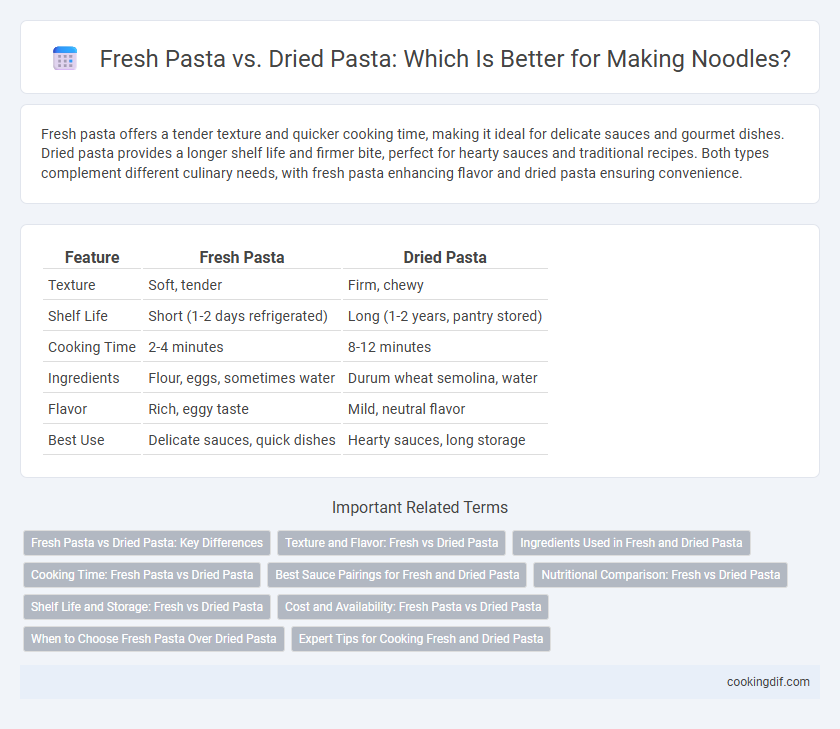Fresh pasta offers a tender texture and quicker cooking time, making it ideal for delicate sauces and gourmet dishes. Dried pasta provides a longer shelf life and firmer bite, perfect for hearty sauces and traditional recipes. Both types complement different culinary needs, with fresh pasta enhancing flavor and dried pasta ensuring convenience.
Table of Comparison
| Feature | Fresh Pasta | Dried Pasta |
|---|---|---|
| Texture | Soft, tender | Firm, chewy |
| Shelf Life | Short (1-2 days refrigerated) | Long (1-2 years, pantry stored) |
| Cooking Time | 2-4 minutes | 8-12 minutes |
| Ingredients | Flour, eggs, sometimes water | Durum wheat semolina, water |
| Flavor | Rich, eggy taste | Mild, neutral flavor |
| Best Use | Delicate sauces, quick dishes | Hearty sauces, long storage |
Fresh Pasta vs Dried Pasta: Key Differences
Fresh pasta contains higher moisture content, resulting in a tender texture that cooks quickly, typically within 2-4 minutes, making it ideal for delicate sauces. Dried pasta, produced by slow drying at low temperatures, boasts a longer shelf life and a firmer texture that holds up well in robust sauces and extended cooking methods. Nutritionally, fresh pasta often has fewer preservatives while dried pasta offers convenience and variety in shapes suited for different culinary applications.
Texture and Flavor: Fresh vs Dried Pasta
Fresh pasta offers a tender, delicate texture with a slightly chewy bite, enhancing the absorption of rich, subtle flavors in sauces. Dried pasta provides a firmer, more al dente texture and a concentrated, nutty flavor due to the dehydration process. Texture and flavor differences influence pairing choices: fresh pasta suits light, creamy sauces, while dried pasta complements robust, tomato-based or hearty meat sauces.
Ingredients Used in Fresh and Dried Pasta
Fresh pasta typically contains eggs, water, and flour, resulting in a tender texture and rich flavor, while dried pasta is primarily made from semolina flour and water, offering a firmer bite and longer shelf life. The higher moisture content in fresh pasta contributes to its quick cooking time, whereas dried pasta requires longer boiling due to its dehydrated state. Egg inclusion in fresh pasta enhances elasticity and color, differentiating it from the denser, more neutral taste of dried pasta.
Cooking Time: Fresh Pasta vs Dried Pasta
Fresh pasta typically cooks in 2 to 4 minutes due to its higher moisture content and delicate texture, making it ideal for quick meals. Dried pasta requires a longer cooking time, usually 8 to 12 minutes, as its low moisture content demands more time to rehydrate and soften. The difference in cooking times affects meal preparation and texture, with fresh pasta offering tender bites and dried pasta providing a firmer, al dente finish.
Best Sauce Pairings for Fresh and Dried Pasta
Fresh pasta, with its tender texture and porous surface, pairs exceptionally well with delicate sauces such as creamy Alfredo, light olive oil, or simple herb-infused butter sauces that allow its flavor to shine. Dried pasta's firm bite and denser consistency hold up perfectly against robust, hearty sauces like rich Bolognese, spicy arrabbiata, and thick tomato-based ragus that cling to the noodles. Understanding these sauce pairings enhances the overall dining experience by complementing the unique characteristics of fresh and dried pasta varieties.
Nutritional Comparison: Fresh vs Dried Pasta
Fresh pasta contains higher moisture content, resulting in a softer texture and slightly fewer calories per serving compared to dried pasta. Dried pasta typically offers a longer shelf life and a higher protein and carbohydrate concentration due to its low moisture level. Both types provide essential nutrients like complex carbohydrates and some B vitamins, but fresh pasta often includes more eggs, which increase its protein and fat content.
Shelf Life and Storage: Fresh vs Dried Pasta
Fresh pasta typically has a shelf life of 1 to 2 days when stored in the refrigerator and up to 8 weeks if frozen, requiring airtight packaging to maintain moisture and prevent spoilage. Dried pasta, on the other hand, can be stored at room temperature for 1 to 2 years in a cool, dry place without refrigeration, offering greater convenience and longevity. Proper storage conditions significantly impact the texture and flavor retention of both fresh and dried pasta varieties.
Cost and Availability: Fresh Pasta vs Dried Pasta
Dried pasta is generally more cost-effective and widely available in supermarkets year-round, making it a convenient option for most households. Fresh pasta, though pricier due to its shorter shelf life and artisanal production, offers a richer texture and flavor but is typically found only in specialty stores or fresh food markets. The choice between fresh and dried pasta often depends on budget constraints and access to fresh pasta suppliers.
When to Choose Fresh Pasta Over Dried Pasta
Fresh pasta offers a tender texture and cooks in just a few minutes, making it ideal for delicate sauces and dishes requiring quick preparation. Choose fresh pasta when recipes call for rich, creamy sauces or when a softer bite complements ingredients like seafood or vegetables. Dried pasta suits longer cooking times and heartier sauces, but fresh pasta enhances flavor absorption in light, subtle noodle dishes.
Expert Tips for Cooking Fresh and Dried Pasta
Fresh pasta cooks significantly faster than dried pasta, typically requiring just 2 to 4 minutes in boiling water, while dried pasta usually takes 8 to 12 minutes. Expert cooking tips recommend salting the water generously and stirring promptly to prevent sticking, with fresh pasta needing gentle handling to avoid tearing. For optimal texture, drain fresh pasta slightly undercooked to finish cooking in the sauce, whereas dried pasta benefits from a complete boil before combining with any sauce.
fresh pasta vs dried pasta for noodles Infographic

 cookingdif.com
cookingdif.com